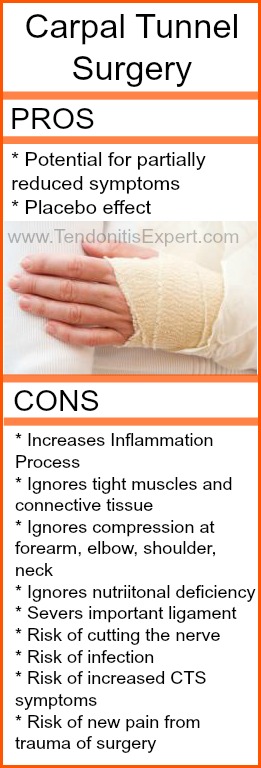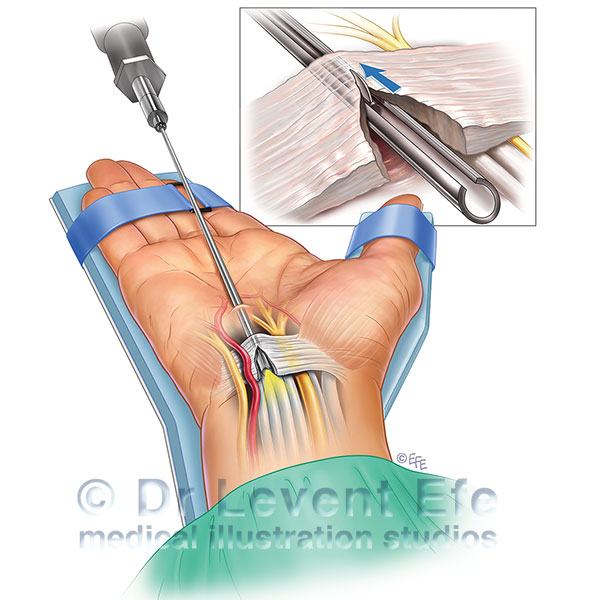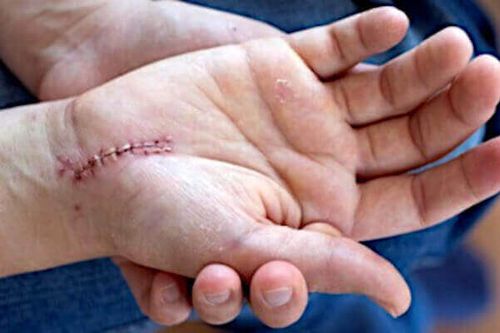During endoscopic carpal tunnel release surgery, the transverse carpal ligament is cut, releasing pressure on the median nerve, relieving the symptoms of carpal tunnel syndrome. The gap where the ligament was cut is expected to eventually fill with scar tissue, but maintaining the now increased space of the carpal tunnel. This is an outpatient surgery allowing you to go home on the same day.
Regardless of an endoscopic or open approach, some patients undergoing carpal tunnel surgery experience pillar pain. Pillar pain is postsurgical pain at the base of the hand on the palm side. It is considered normal for the first 2-6 weeks after surgery. If symptoms of pillar pain are present beyond 3 months from the time of surgery, I may prescribe formal hand therapy to help reduce swelling and discomfort, and to restore grip strength.
I may also recommend workup for other conditions that sometimes account for persistent pain after carpal tunnel surgery, such as wrist or thumb arthritis. Endoscopic carpal tunnel release is a means of dividing the ligament that is placing too much pressure on the median nerve from the inside out. It involves a smaller incision and a slightly faster recovery, but usually requires general anesthesia or intravenous sedation.
Open carpal tunnel surgery involves a longer incision, but can be performed under local anesthesia. This may be a better option for patients who are at higher risk for complications during general anesthesia. Rarely, a patient scheduled to undergo endoscopic carpal tunnel surgery ends up being converted to an open approach.
The most common reason for this is the inability to get a clear view of the ligament through the camera at the time of surgery, usually because of swollen tissue or unusual anatomy. The median nerve and the tendons that bend and flex your fingers pass through the narrow area of the wrist called the carpal tunnel. In carpal tunnel release surgery, the surgeon cuts the transverse carpal ligament, a band of tissue on the palm side of the carpal tunnel. This takes pressure off the median nerve and relieves symptoms. You will still be able to use your wrist and hand, and eventually scar tissue will form where the ligament was cut.
The median nerve and tendons that allow your fingers to move pass through a narrow passageway in the wrist called the carpal tunnel. The carpal tunnel is formed by the wrist bones on the bottom and the transverse carpal ligament across the top of the wrist. When this part of the body is injured or tight, swelling of the tissues within the tunnel can press on the median nerve.
This causes numbness and tingling of the hand, pain, and loss of function if not treated. Symptoms usually start slowly, and may get worse over time. It is not uncommon for a person to have carpal tunnel in both hands. It's not uncommon for a person to have carpal tunnel in both hands. The median nerve and several tendons run from the forearm to the hand through a small space in the wrist called the carpal tunnel. The median nerve controls movement and sensation in the thumb and first 3 fingers.
Mild-to-moderate carpal tunnel syndrome can be treated non-surgically. But if symptoms are severe or keep coming back, your physician may recommend a surgical procedure called carpal tunnel release. During carpal tunnel surgery, the transverse carpal ligament is cut in order to release the pressure from the median nerve and to relieve pain. The interviewees placed a strong emphasis on the need for formally authorised work absence . This perhaps suggests that those with more experience in treating CTR patients believe that earlier return to work (i.e. before the patient is 100% fit) is not detrimental to recovery.
This suggests the potential power that appropriate evidence-based return to work advice could have if delivered and documented by the surgeon. Receiving authorised time off work appeared to be beneficial to the interviewees' experience, but for some adherence to this prescribed time period became a barrier to earlier return to work. The current NHS guidance for patients, available on the 'common health questions' NHS website is potentially ambiguous . It states that "You should go back to work as soon as you feel able to and, with your employer's agreement. In practice, it may not be clear to the patient which of these statements best applies to them. The risk and complication rates of open surgery are very low.
After open surgery, recovery may be slower than after endoscopic surgery. There are also the risks of any type of surgery, including possible infection and risks of general anesthesia. But most open carpal tunnel surgery is done with local anesthesia or regional block rather than with general anesthesia. The recovery from carpal tunnel surgery takes time – anywhere from several weeks to several months.
If the nerve has been compressed for a long period of time, recovery may take even longer. Recovery involves splinting your wrist and getting physical therapy to strengthen and heal the wrist and hand. Most people who have carpal tunnel release surgery experience a full recovery and no recurrence of symptoms. In very severe cases, there may always be some lingering tingling or numbness from time to time. For more information about carpal tunnel syndrome and surgery options, speak with an orthopedic or hand surgeon. If you are preparing to undergo carpal tunnel release surgery, you may be wondering what to expect in the coming weeks and in the months post-surgery.
Wide-awake local anesthesia is surgery performed with only local anesthesia, allowing the patient to avoid grogginess, and even drive him or herself home after surgery, if necessary. A diagnosis of carpal tunnel syndrome is about the only reason to have a carpal tunnel surgery. And even then, your doctor will likely want you to try nonsurgical treatments first. These may include over-the-counter pain medicines, physical therapy, changes to the equipment you use at work, wrist splints, or shots of steroids in the wrist to help relieve swelling and pain.
Viewing images of the inside of the wrist and hand on the monitor, the surgeon uses a small, specialized knife to divide the transverse carpal ligament, similar to the open procedure. During open carpal tunnel release surgery, the surgeon makes a small incision in the palm and views the inside of the hand and wrist through this incision. The surgeon then divides the transverse carpal ligament , to increase the size of the tunnel and reduce pressure on the median nerve.
The ligament may gradually grow back together post-surgery, but there will be more space in the carpal tunnel. A person having surgery on both wrists, or who depends on a wheelchair, a walker, or crutches, may choose endoscopic surgery because the healing time can be shorter than with open surgery. Some form of rehabilitation is common after carpal tunnel release surgeries.
You will also likely wear a wrist brace—a carpal tunnel brace—for a few weeks after surgery. Initially, therapy will focus on range-of-motion exercises for your wrist. Eventually, it will include strengthening exercises and scar management. Talk with your doctor or therapist about managing the pain so you can reach your recovery goals. Carpal tunnel release surgery – also called carpal tunnel decompression – involves cutting your carpal ligament. This ligament is connected to bones in your wrist to form the carpal tunnel.
Several tendons and your median nerve, which controls movement and feeling in your hand, run through this tunnel to your fingers. In carpal tunnel syndrome, your median nerve becomes compressed, typically causing tingling, numbness and pain in your hand. Dividing the carpal ligament releases the pressure in your carpal tunnel and can ease your symptoms. During endoscopic carpal tunnel release surgery, the transverse carpal ligament is cut. This releases pressure on the median nerve, relieving carpal tunnel syndrome symptoms.
ECTR offers quicker recovery, less pain on the operated hand, and earlier return to work/daily activities compared to the open carpal tunnel surgery. Many patients feel relief of their numbness and tingling that wakes them up at night within 1-2 days after surgery. Most patients can return to light-duty work after an average of 2 to 7 days, and can regain full function of their hands within about four weeks.
Carpal tunnel syndrome causes tingling, numbness, or pain in the hand. The wrist bones and ligament form a tunnel, a passage for the median nerve and finger tendons. Repetitive strain may cause swelling that pinches and traps the nerve within the tunnel. Prompt treatment increases the chances that symptoms will stop and long-term nerve damage will be prevented. Self-care includes modifying activities, stretching, and icing.
Conservative treatments include physical therapy, a wrist brace, or medications. Surgery that re-opens the space and frees the nerve may be an option. Following surgery, soreness around the incision may last for several weeks or months. However, heavy gripping and lifting may cause pain for awhile. Numbness and tingling may disappear quickly or slowly, and it may take several months for strength in the hand and wrist to return to normal. Carpal tunnel symptoms may not completely go away after surgery, especially in severe cases.
As with all surgical procedures, specific recovery time varies by patient and demand. The surgeon will cut the transverse carpal tunnel ligament to decrease pressure on the median nerve. With open surgery, the surgeon makes an incision in the skin of your palm.
This provides a view of the transverse carpal ligament and other tissues. Open surgery leaves a bigger scar, and may require longer recovery. There may be fewer complications than with endoscopic surgery. In an endoscopic carpal tunnel release, the surgeon makes 2 half-inch cuts. Then they put a camera attached to a narrow tube into one cut.
The camera guides the surgeon as they insert the instruments and cuts the carpal ligament through the other incision. When possible, the endoscopic carpal tunnel release is the preferable option for most patients. After either procedure, patients often experience symptom relief almost immediately after surgery.
The bandages from surgery need to stay on for up to 2 weeks. During this period of healing, the surgeon may recommend some exercises to help prevent stiffness in the fingers. During open carpal tunnel release surgery, the transverse carpal ligament is cut, which releases pressure on the median nerve and relieves the symptoms of carpal tunnel syndrome.
Carpal tunnel release surgery is an operation to relieve symptoms of carpal tunnel syndrome , including numbness, tingling and pain in your hand. The operation involves dividing a ligament in your wrist to relieve pressure on a nerve that controls movement and feeling in your hand. Possible problems from endoscopic carpal release surgery include injury to nerves, blood vessels, and tendons.
But most endoscopic carpal tunnel surgery is done with local anesthesia or regional block rather than with general anesthesia. Once the splint is removed, you will likely begin a physical therapy program. The physical therapist will teach you motion exercises to improve the movement of your wrist and hand. These exercises will speed healing and strengthen the area. You may still need to sometimes use a splint or brace for a month or so after surgery.
Endoscopic surgery shortened the recovery period as compared to open surgery. While individual results vary, most patients retum to normal daily activities within days after endoscopic surgery and return to work earlier than those who undergo the open surgery. Recovery of hand strength by open surgery can take weeks or even months while the palm heals. In an endoscopic carpal tunnel release, the surgeon makes 2 half-inch incisions. Then he or she inserts a camera attached to a narrow tube into one incision. The camera guides your surgeon as he or she inserts the instruments and cuts the carpal ligament through the other incision.
You will have a light bandage covering the incision that permits immediate wrist and hand motion. You will be encouraged to periodically move your fingers into a fist and straighten them out in order to prevent stiffness. It is important to ice and elevate the operated hand to limit swelling. Most patients will have the option of removing the surgical bandage 3 days after surgery and replacing it with a fabric bandaid. For the first 4 weeks after surgery, you should avoid forceful gripping, grasping, bearing weight, or lifting heavy items with your operated hand.
Typing, operating a mouse or phone, and driving are permissible the day after surgery. The incision should be kept dry until healed, usually 1-2 weeks. Carpal tunnel surgery is a routine procedure used to treat carpal tunnel syndrome, an overuse condition that develops from performing repetitive movements or a genetic disposition.
The carpal tunnel consists of the transverse carpal ligament on top of the wrist and the wrist bones below. When tissues in this area swell, they put pressure on the median nerve, leading to numbness and pain. In an endoscopic carpal tunnel release, the doctor makes 2, half-inch incisions.
The camera guides your doctor as he or she inserts the instruments and cuts the carpal ligament through the other incision. Carpal Tunnel Syndrome is caused by increased pressure in the carpal tunnel and subsequent compression of the median nerve. The most common complaints are pain, numbness, and tingling, especially of the thumb, index, and middle fingers. Symptoms are usually worse at night; people often find themselves waking up from sleep and having to "shake out" their hands to alleviate symptoms. Many people also have difficulty manipulating small objects or have weakness in those same fingers.





























No comments:
Post a Comment
Note: Only a member of this blog may post a comment.